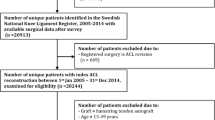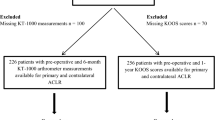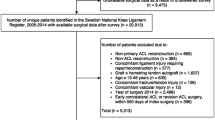Abstract
Purpose
To evaluate whether graft-type and tunnel location in ACL reconstruction impact patient-reported outcomes in individuals over the age of 45.
Methods
From 2015 to 2018, patients over 45 years old undergoing primary ACL reconstruction without multi-ligamentous injuries were enrolled in an institutional registry. Baseline International Knee Documentation Committee (IKDC) subjective scores, Knee Injury and Osteoarthritis Outcome Scores (KOOS), Marx Activity Scale, and patient characteristics were collected. Follow-up occurred at a minimum of two years to obtain patient-reported outcomes.
Results
Of the 51 patients who qualified for the study, 44 (86.3%) patients were available at a minimum of two years after surgery date (range 24–60 months). Average age at time of surgery of the available patients was 51.6 ± 4.87 (range 45–66). Between femoral tunnel drilling methods, there were no differences in the proportion of patients achieving clinically significant improvement or post-operative outcome scores. While patients who received patellar tendon autografts were more likely to achieve clinically significant improvement in the KOOS sports subscale, there were no other differences in outcomes measures between graft types. Two patients had a retear of their graft, and an additional five patients complained of subjective instability.
Conclusions
In patients over the age of 45, neither the method used to create the femoral tunnel nor the graft type used in ACL reconstruction caused a significant difference in post-operative PROMs with a minimum of two years of follow-up.
Level of Evidence
Therapeutic IV, Case Series.



Similar content being viewed by others
References
Christensen K, Doblhammer G, Rau R, Vaupel JW (2009) Ageing populations: the challenges ahead. Lancet 374(9696):1196–1208
Oeppen J, Vaupel JW (2002) Demography: Broken limits to life expectancy. Science 296(5570):1029–1031
Jenkin CR, Eime RM, Westerbeek H, O’Sullivan G, Van Uffelen JGZ (2017) Sport and ageing: A systematic review of the determinants and trends of participation in sport for older adults. BMC Public Health. https://doi.org/10.1186/s12889-017-4970-8
Foster TE, Wolfe BL, Ryan S, Silvestri L, Krall KE (2010) Does the graft source really matter in the outcome of patients undergoing anterior cruciate ligament reconstruction?: An evaluation of autograft versus allograft reconstruction results: A systematic review. Am J Sports Med 38(1):189–199
Duchman KR, Lynch TS, Spindler KP (2017) Graft Selection in Anterior Cruciate Ligament Surgery: Who gets What and Why? Clin Sports Med 36(1):25–33
Toanen C, Demey G, Ntagiopoulos PG, Ferrua P, Dejour D (2017) Is There Any Benefit in Anterior Cruciate Ligament Reconstruction in Patients Older Than 60 Years? Am J Sports Med 45(4):832–837
Brown CA, McAdams TR, Harris AHS, Maffulli N, Safran MR (2013) ACL reconstruction in patients aged 40 years and older: A systematic review and introduction of a new methodology score for ACL studies. Am J Sports Med 41(9):2181–2190
Kim DK, Park G, Kuo LT, Park WH (2019) Patients older than 50 years had similar results of knee strength and anteroposterior stability after ACL reconstruction compared to younger patients. Knee Surgery, Sport Traumatol Arthrosc 27(1):230–238
Desai N, Björnsson H, Samuelsson K, Karlsson J, Forssblad M (2014) Outcomes after ACL reconstruction with focus on older patients: Results from The Swedish National Anterior Cruciate Ligament Register. Knee Surgery, Sport Traumatol Arthrosc 22(2):379–386
Trojani C, Sané JC, Coste JS, Boileau P (2009) Four-strand hamstring tendon autograft for ACL reconstruction in patients aged 50 years or older. Orthop Traumatol Surg Res 95(1):22–27
Nishio Y, Kondo E, Onodera J et al (2018) Double-Bundle Anterior Cruciate Ligament Reconstruction Using Hamstring Tendon Hybrid Grafts in Patients Over 40 Years of Age: Comparisons Between Different Age Groups. Orthop J Sport Med. https://doi.org/10.1177/2325967118773685
Fayard JM, Wein F, Ollivier M et al (2019) Factors affecting outcome of ACL reconstruction in over-50-year-olds. Orthop Traumatol Surg Res 105(8):S247–S251
Robin BN, Jani SS, Marvil SC, Reid JB, Schillhammer CK, Lubowitz JH (2015) Advantages and Disadvantages of Transtibial, Anteromedial Portal, and Outside-In Femoral Tunnel Drilling in Single-Bundle Anterior Cruciate Ligament Reconstruction: A Systematic Review. Arthrosc - J Arthrosc Relat Surg 31(7):1412–1417
Chalmers PN, Mall NA, Cole BJ, Verma NN, Bush-Joseph CA, Bach BR (2013) Anteromedial versus transtibial tunnel drilling in anterior cruciate ligament reconstructions: A systematic review. Arthrosc - J Arthrosc Relat Surg 29(7):1235–1242
Pearle AD, McAllister D, Howell SM (2015) Rationale for Strategic Graft Placement in Anterior Cruciate Ligament Reconstruction: I.D.E.A.L. Femoral Tunnel Position. Am J Orthop 44(6):253–258
Fitzgerald J, Saluan P, Richter DL, Huff N, Schenck RC (2015) Anterior Cruciate Ligament Reconstruction Using a Flexible Reamer System: Technique and Pitfalls. Orthop J Sport Med. https://doi.org/10.1177/2325967115592875
Wein F, Osemont B, Goetzmann T et al (2019) Anteversion and Length of the Femoral Tunnel in ACL Reconstruction: In-Vivo Comparison Between Rigid and Flexible Instrumentation. J Exp Orthop 6:26
Marx RG, Stump TJ, Jones EC, Wickiewicz TL, Warren RF (2001) Development and evaluation of an activity rating scale for disorders of the knee. Am J Sports Med 29(2):213–218
Roos EM, Lohmander LS (2003) The Knee injury and Osteoarthritis Outcome Score (KOOS): From joint injury to osteoarthritis. Health Qual Life Outcomes 1:64
Irrgang JJ, Anderson AF, Boland AL et al (2001) Development and validation of the International Knee Documentation Committee Subjective Knee Form. Am J Sports Med 29(5):600–613
Marx RG, Connor J, Lyman S et al (2005) Multirater agreement of arthroscopic grading of knee articular cartilage. Am J Sports Med 33(11):1654–1657
Wright RW, Preston E, Dunn WR et al (2008) A Systematic Review of Anterior Cruciate Ligament Reconstruction Rehabilitation Part II: Open Versus Closed Kinetic Chain Exercises, Neuromuscular Electrical Stimulation, Accelerated Rehabilitation, and Miscellaneous Topics. J Knee Surg 21(3):225–234
Harris JD, Brand JC, Cote MP, Faucett SC, Dhawan A (2017) Research Pearls: The Significance of Statistics and Perils of Pooling. Part 1: Clinical Versus Statistical Significance. Arthroscopy 33(6):1102–1112
Irrgang JJ, Anderson AF, Boland AL et al (2006) Responsiveness of the International Knee Documentation Committee Subjective Knee Form. Am J Sports Med 34(10):1567–1573
Mehta A, Lin CC, Campbell RA et al (2019) Effects of anteromedial portal versus transtibial ACL tunnel preparation on contact characteristics of the graft and the tibial tunnel aperture. CiOS Clin Orthop Surg 11(1):52–59
Tampere T, Devriendt W, Cromheecke M, Luyckx T, Verstraete M, Victor J (2019) Tunnel placement in ACL reconstruction surgery: smaller inter-tunnel angles and higher peak forces at the femoral tunnel using anteromedial portal femoral drilling—a 3D and finite element analysis. Knee Surg Sport Traumatol Arthrosc 27(8):2568–2576
Robin BN, Jani SS, Marvil SC, Reid JB, Schillhammer CK, Lubowitz JH (2015) Advantages and Disadvantages of Transtibial, Anteromedial Portal, and Outside-In Femoral Tunnel Drilling in Single-Bundle Anterior Cruciate Ligament Reconstruction: A Systematic Review. Arthroscopy 31(7):1412–1417
Barrett AM, Craft JA, Replogle WH, Hydrick JM, Barrett GR (2011) Anterior cruciate ligament graft failure: A comparison of graft type based on age and tegner activity level. Am J Sports Med 39(10):2194–2198
Cinque ME, Chahla J, Mitchell JJ et al (2018) Influence of Meniscal and Chondral Lesions on Patient-Reported Outcomes After Primary Anterior Cruciate Ligament Reconstruction at 2-Year Follow-up. Orthop J Sport Med. https://doi.org/10.1177/2325967117754189
Funding
All authors certify that they have no affiliations with or involvement in any organization or entity with any financial interest or non-financial interest in the subject matter or materials discussed in this manuscript. The authors have no financial or proprietary interests in any material discussed in this article.
Author information
Authors and Affiliations
Contributions
NSS performed data analysis, drafted this manuscript, and provided final approval. BMB performed data collection, revised this manuscript, and provided final approval. RMB revised this manuscript and provided final approval. RSS performed data collection, revised this manuscript, and provided final approval. KAH performed data collection, revised this manuscript, and provided final approval. CJU substantially contributed to conception and design, revised the manuscript, and provided final approval. BRB substantially contributed to conception and design, revised the manuscript, and provided final approval. AJC substantially contributed to conception and design, revised the manuscript, and provided final approval. BMG designed this project, revised the manuscript, assisted with drafting, and provided final approval.
Corresponding author
Ethics declarations
Conflict of interest
The authors have no relevant financial or non-financial interests to disclose. The authors have no conflicts of interest to declare that are relevant to the content of this article.
Additional information
Publisher's Note
Springer Nature remains neutral with regard to jurisdictional claims in published maps and institutional affiliations.
Rights and permissions
About this article
Cite this article
Shah, N.S., Bacevich, B.M., Boxer, R.M. et al. Graft choice or drilling technique does not influence outcomes of ACL reconstruction in patients over forty-five. Eur J Orthop Surg Traumatol 32, 1609–1616 (2022). https://doi.org/10.1007/s00590-021-03139-1
Received:
Accepted:
Published:
Issue Date:
DOI: https://doi.org/10.1007/s00590-021-03139-1




